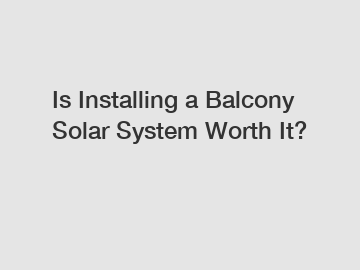10 Advantages of a Modular UPS
Jun. 24, 2024
10 Advantages of a Modular UPS
What is a Modular UPS?
Modular UPS is not to be confused with Parallel UPS in our definition.
ZHONGKANG are exported all over the world and different industries with quality first. Our belief is to provide our customers with more and better high value-added products. Let's create a better future together.
Power Sonic's definition of a Modular UPS is where a unit is able to provide N+1 or N+X redundancy as well as being able to grow as power requirements increase. This is achieved by adding additional modules which can slot into a chassis on an individual basis.
In environments where total reliability is of great importance, a single UPS can be a single point of failure that can also disrupt many other systems.
To provide greater reliability, multiple smaller UPS modules and batteries can be integrated together to provide redundant power protection equivalent to one very large UPS with additional modules to provide
redundancy if there is failure of one of the modules. In this way, failure of one module will not impact system or site operation.
Modular Three Phase UPS systems are becoming typical on many data centre and critical power applications, this is due to the systems being based on small, light, compact, hot swappable, low cost modules which can be added when needed, or indeed more modules can be added for additional redundancy.
In this blog post we try to cover the merits with also the typical flaws. Most current Three Phase UPS systems have parallel or scaling ability, which enables to add parallel UPS units whenever additional power or redundancy is required.
For example; if 100KVA is maximum load then 2 x 100KVA systems will be required as a bare minimum, this is without taking into consideration efficiency of load or growth. A unique scalable solution is provided
by a Modular UPS approach.
A Modular UPS is generally based on a rack type enclosure that includes battery cabinet at its bottom or in a separate rack, and hot swappable modules located one above the other, which can be added whenever more power is required, or greater level of redundancy is required.
Advantages of a Modular UPS
- REDUNDANCY
All UPS systems are designed to work continuously during life time of UPS. A Modular UPS is designed to be flexible when more redundancy is required. Thereby minimising failure. The general idea being, the more modules with free and spare capacity, then there is a greater the level of redundancy. For example, if a load is 80KVA and the modular UPS provided is rated at 120KVA populated by 20KVA modules, then the end result will be N+2. By adding further modules then you can increase the redundancy aspect, thereby reducing the possibility of total UPS failure.
- LOWER COST OF INSTALLATION
Modular UPS can in many instances be more cost effective than installing parallel or scalable UPS systems. For example, if the requirement is for 100KVA with N+1 redundancy, then a modular solution will be 120KVA made up of 6 x 20KVA modules as opposed to 2 x free standing 100KVA UPS systems. The cost of installation will also be lower.
- DELIVERY, OFFLOADING AND POSITIONING
A standalone or parallel UPS is one unit and can be problematic when delivering on site. They can be very large as well as heavy. A Modular UPS can be broken down into parts and assembled back in on site. This can reduce costs on delivery as well as making sites more accessible.
- LOWEST FLOOR SPACE, COMPARED TO OTHER SCALABLE /
PARALLEL SOLUTIONS
Conventional UPS systems take up more space due to the fact they are typically extended horizontally on the floor. The modular UPS typically increases typically vertically in the rack. Thereby using less floor space. Secondly, less UPS batteries need to be used if the conventional UPS has separate battery cabinets.
- GREATER LEVEL OF EFFICIENCY WITH SCALABLE LOAD
A UPS is generally not working at its best when running at 100% load. With a modular UPS by maintaining a high ratio of load to UPS capability will mean that the UPS is working in its most efficient way. For example, if the load is 60-70KVA, then we would recommend that the UPS if in modular format should be 80KVA with one extra 20KVA module, providing a total of 100KVA.
- REDUCTION OF FAILURE DURING MAINTENANCE / SUPER-FAST REPLACEMENT (MTTR)
A typical standalone UPS system will go onto bypass during failure or overload etc. The UPS will generally have to be isolated during repair or technical evaluation to assess the unit. Once assessed and problem found on the failed UPS there is time for part replacement, and if part is not available then further time is required when parts are available and sent to site.
With a modular unit, the faulty module is simply removed and replaced with a new system. This action can take literally seconds as the faulty module will removed and replaced during live conditions so there is no loss of power or loss of UPS backup. Many manufacturers of modular UPS systems however, still have a singular point of failure on the system itself and that is by having a singular static switch. If this fails, then the system fails. Power Sonic provide modular UPS
systems with static switches built into each module.
- GET MORE POWER FROM SAME INFRASTRUCTURE
If, for example, your site is cabled and capable of supporting 2 x 100KVA parallel standalone UPS systems, therefore the load you anticipate putting onto the UPS must not be greater than 100KVA. Otherwise you will not get redundancy, or alternatively you will
overload each UPS. With a modular system if you are aiming to get
redundancy you will only need to add 1 x additional module to achieve this.
For example; if you require redundancy and have chosen a 20KVA scalable modular system, all you will need to do is add 1 x additional 20KVA module. So, based on the example above against 2 x 100KVA systems you will simply have a 120KVA modular system.
Furthermore; if your site is already capable of being able to support 2 x 100KVA parallel UPS systems, then a modular UPS will enable you to have full usage of the infrastructure and enable power growth up to 200KVA rather than 100KVA full load scenario.
- LOWER COST OF BATTERIES
A Modular UPS will as a general rule of thumb, have a centralised battery which is shared by the modules. With a standalone / parallel UPS there is a need to have 2 x separate batteries covering each UPS, thereby increasing battery costs.
Power Sonic can offer modular UPS systems with centralised battery or parallel battery. Furthermore; we can also offer standalone UPS systems with common battery. The choice is yours.
- LOWER COST OF REPAIR
In the event of catastrophic failure of standalone / Parallel UPS and the system has to be replaced in its entirety due to parts not being available or replacement not being available, compared to catastrophic failure of one module then the costs will typically be 10-20 times in comparison to a single module replacement. It will be even worse if both standalone systems if running in parallel are to be replaced.
- LOWER COST OF OWNERSHIP OVER LIFETIME
A singular Modular UPS system will simply cost less to run than if 2 x Parallel UPS systems are running at the same time. For example, if the site has 80KVA load and a 100KVA modular system is purchased then the running costs will less than if the site had purchased 2 x 80KVA standalone parallel systems. A standalone solution may cost more than double to run over the lifetime. Depending on your electricity tariffs the UPS company can provide details of how much energy is
used in every scenario and cost. We can save your site money. We can also recommend other factors on site such as power factor correction and carbon reduction via carbon off set.
A modular UPS system will provide a perfect solution based on many parameters, however cost and functionality nearly always come into play. If you have a requirement for a UPS system please contact one of our experts to help you choose the right solution for you.
Uninterruptible Power Supply System Benefits | Learn More
How to Avoid Power Outages with an Uninterruptible Power Supply System
There aren't many successful businesses that can function well without electricity. You can easily imagine the worst-case scenarios and find the real-life horror stories: Business is humming along and all seems right with the world, until the building or site loses power.
Jump To Sections:
Lights go out, computer screens darken, machinery stops and productivity screeches to a halt as you immediately worry about lives, injury, safety and damage. You also don't want to be one of the American businesses that collectively lose about $50 billion annually due to power failure. These facts underscore the need for a failsafe backup plan.
Industry News From Warren Cat
Right To Your InboxLeave This Blank:Leave This Blank Too:Do Not Change This:
Your :
Any outage scenario causes worry and wonder among employees, as well as stress and strain for the team in charge. Instead of working efficiently, everyone gathers around a window to see or discuss the cause, which can be one of many things.
Common Reasons for Power Loss
Utility companies routinely summarize the reasons for any power outages in their newsletter or regular reports. The causes range from everything in the list above to animals making their way into transformers and other components. Whether the power outage lasts a few seconds or several days, business operations need to continue. And they need do so continuously and consistently.
The causes may vary, but outages cause worry about how projects will finish on time and on budget. Every business and household needs lights, heat, equipment and other necessities to function, and certainly to prosper. Without power, injury, loss, damage and decreased revenue become unwelcomed realities.
Now imagine a different scenario when there's an interruption in the power supply. A UPS keeps everything running seamlessly through a short-term outage. In the case of a long-term outage, it allows plenty of time for conversion to an alternate power source. Imagine that yours is the building that keeps humming despite the circumstances, and the people inside it experience calmness instead of chaos.
What is an Uninterruptible Power Supply System?
UPS stands for uninterruptible power supply. And with a complete system, you can remove 'power outage' from your list of worries. The technology continues to improve as the importance of maintaining power to essential systems and operations becomes more and more critical.
Many people don't realize how much the data-driven world has changed overall power needs, as the Internet and big data in general keep driving up demand for cleaner and more reliable power. Energy surges, spikes or dips cause fluctuations and irregularities that can adversely affect your equipment and your data, so the systems provide a clean, consistent and uninterrupted power flow that protects against those effects.
Many refer to the concept of backup power as a 'backup plan,' and a UPS plays a big part of it. A UPS might be a single-phase or triple-phase configuration and could be powered by an array of batteries or a flywheel component.
Generally speaking, an uninterruptible power supply system can be anything from the little black box that sits somewhere near your desk and protects your personal computer to the mega-ton, megawatt models with the capacity to power big business.
A UPS System Serves Multiple Purposes:
- Protect against power interruptions
- Provide adequate power during short-term interruptions and 'ride-through' time to convert to backup supply
- Refine the quality of the power as it reaches your building, office and equipment
- Include a backup source for long-term outages, such as generators
You will typically find battery-based systems in smaller operations like the home computer or office and the flywheel configuration in bigger systems used to power large facilities. The flywheel-type UPS can augment or replace batteries and deliver immediate, continuous and ample power during an outage or during a switch to an alternate power source.
Different UPS systems work in different ways. The Office of Science and Technical Information provides in-depth information about the harmonics and electrical systems of UPSs, and so do the companies that sell and manufacture them. A UPS will normally be one of three main types, or sometimes a combination of them.
The Main Types of UPS Systems
- A standby UPS system might also be called an offline or line-preferred UPS. It normally has an inverter, battery, static switch, low-pass filter and surge suppressor. The system remains on standby unless there's a primary power failure.
- A line-interactive UPS system contains a battery and inverter that are always connected to the output, and if power fails, a switch changes the electrical flow. The continuous connection provides superior filtering.
- A double conversion UPS system has a backup battery that is charged by the input AC and powers the output inverter for a seamless switch.
The bigger systems usually include a switch gear and power transformers to provide consistent, reliable electricity and guarantee from zero to only seconds per year of downtime. Critical-operation facilities require a clean, stable and consistent power supply. The UPS can act as a filter for the power coming in from a utility source and protect against the outages and other anomalies that originate with the source.
Additional reading:How Does Sustainable Packaging for E-commerce Deliver Value?
10 Questions You Should Know About Solar Energy Solutions for Eco-Friendly Boats
Maximizing Efficiency: AC Energy Meters in Grids
Maximize Efficiency with AC Energy Meters for IT
What is energy management software?
The Advantages and Disadvantages of crystal oscillator ...
How to Select the Best IoT Wireless Power Usage Tracker?
For more information, please visit Mini UPS.
Anywhere you have operations that can't stop, there is a type of UPS available to make sure they don't. The various types are as follows:
- Data: A UPS for applications such as a server farm or communication center.
- High Temp: Some people need a UPS that will withstand hotter-than-average environments.
- Industrial UPS System: These power systems are geared toward use in such settings as manufacturing and other types of plants and factories.
- Medical: Hospitals and other medical settings use a UPS to ensure continuous operation of critical equipment like life support.
- Military: Systems are certified for quality under military specifications.
Benefits of Uninterruptible Power Supply Systems
The government's Energy Star website points to the efficiency strengths of a UPS. It can protect against power surges or other variations like frequency distortion or voltage drops. Energy Star-rated UPS systems can help reduce general energy loss by as much as 55%. For example, a 1,000-kVA UPS used in a data-center application could save as much as $18,000 per year in energy costs.
Advantages of Using an Uninterruptible Power Supply System
- Continuity: Experience no outages to critical equipment like computers to factory production lines.
- Consistency: Electronics within a UPS tells it when it needs to work and kicks in alternate power as needed, which eliminates glitches or surges and allows time to safely shut down main systems if and when needed.
- Protection: Safeguards against all the oddities of electricity such as surges, spikes, dips and failure because the UPS essentially senses those things and switches to alternate power before the anomalies cause damage.
- Filter: A line-interactive UPS acts as a kind of filter by refining the power as it comes into the UPS then adjusting its output so that internal systems receive a clean, consistent supply free of abnormalities.
While UPS systems provide exceptional reliability and protection and keep critical systems running, they require some investment and preparation. The smallest UPS to power your home office or computer can be several hundred dollars.
The Benefits Outweigh the Costs
Depending on the options and features, the UPS system for a hospital, data center or emergency medical service, for example, might be an investment of tens of thousands of dollars, but it begins paying returns immediately in protection. For the long-term, an efficient UPS can pay for itself within a few years based on reduced energy costs alone. This is one of the many benefits of uninterruptable power supply systems.
Be prepared to pay an electrician for anything more than basic installation of the smallest system. Hobbyists and the inexperienced should know that attaching a UPS and its accouterments is a job for the professionals. Most UPS systems need a cool, dry, dust-free place to exist, and if you choose a battery-based system, know that the batteries last about 5'10 years and must be disposed of properly according to environmentally friendly standards.
Most UPS systems draw power in order to remain charged, so some people are surprised to see the initial spike in energy use before the long-term efficiency proves itself.
These are just some of the industries that can benefit from UPS Systems:
- Hospitals and medical centers
- Electronics manufacturers
- Data and call centers
- Banks
- TV stations
- Production-based manufacturers
- Telecommunications and cable companies
- Universities
- Utility companies
How Do Uninterruptible Power Supply Systems Work?
The different types work different ways, but they all aim to store power then supply it when needed. In a data-driven world, even a momentary glitch with the power has the capacity to result in lost data, zapped systems, missed changes, corrupt files and lost production.
A flywheel or battery-powered UPS plugs into a power source, draws energy, stores the energy. Many times, it filters and refines it as well. The three main types of uninterruptible power supply systems are standby, interactive line, and online.
Power consumption as it relates to UPSs is expressed in VA or kVA. The best way to determine your needs is to consult an expert, but you can roughly calculate the VA or kVA value you might need using the total consumption in watts and the power factor.
For example, maybe a desktop computer is 400 W with a power factor of 0.8. You'd divide the wattage by the power factor to get the VA: 400 ÷ 0.8 = 500 VA. If the power is expressed in amps, multiply the amps by the input volts to get the VA.
The best advice: Consult a professional as you figure out your UPS needs and keep in mind that the large-scale models require sophisticated calculations to make sure each component fits the application.
Standard UPS features can include a number of benefits, such as the following:
- Little electromagnetic interference and acoustic noise
- Reduced-distortion input current (THD)
- Regulated output
- Short transition from regular to backup power
- Highly efficient and reliable
Most consumers only see or buy the smaller types of UPS systems, but many of them exist that are big enough to protect and power any kind of business.
Flywheel UPS Systems Are Leaner and Cleaner
A Caterpillar® UPS with flywheel technology, available through Warren CAT, provides the most superior power and advanced technology in UPS systems. They feature an exclusive kinetic-energy storage device that functions like a traditional UPS but without batteries and with a lot less maintenance and hassles.
The complete line of Cat® UPS systems offers capabilities that range from 150 kVA to 3.6 MVA. They will carry a facility through an outage or interruption. Depending on the model and technology, they will refine the incoming power so it's as clean as your system needs it to be. Flywheel-style Cat UPS systems have several advantages like no-break technology and an infinite life cycle.
The Components of a Flywheel UPS System
- Input contactor
- Static switch
- Line conductor
- Inverter fuse
- Filter inductor
- Utility converter
- Flywheel converter
- Flywheel system
- Bypass and output contactors
Options include cabinets with static bypass, MMU isolation, MMU connection, maintenance bypass and dual output. The flywheel motor compartment contains no permanent magnets and has a magnetic bearing integrated into the field circuit.
Advantages of a Flywheel UPS System
- Produces superior-quality output
- Eliminates batteries or reduces the number
- Lowers system maintenance, operating and replacement costs
- Requires less upkeep
- Needs less space at a size that's about 75% smaller than battery-based systems
- Reduces annual, overall energy costs by as much as 4%
- Provides fail-safe backup power
- Option for high-temp operation up to 104 degrees Fahrenheit
- Poses no safety hazard to employees or the environment
- Enables easy expansion through modular, scalable architecture
A flywheel UPS addresses both efficiency and environmental considerations. For example, a traditional battery-based UPS of say, 300 kVA, would occupy 40 square feet, weigh about 13,000 pounds and use about 52,269 BTUs. A Cat UPS 300 kVA system would occupy 14 square feet, weigh 4,475 pounds and use about 25,300 BTUs.
One of the Cat UPS systems is a high-endurance model designed to operate at temperatures as low as -4 degrees Fahrenheit and as hot as 104 degrees F. You can put monitoring equipment for the Cat UPS system anywhere in the building, with optional Ethernet connections and various choices for computer display.
Caterpillar ingenuity masters the science of using kinetic energy to provide a true, uninterrupted power supply. When power surges, dips or ceases, inertia enables the rotor to keep spinning and create kinetic energy to convert to electricity. The flywheel spins with such low resistance (virtually none), that frictional loss remains very low, thereby creating a super-efficient environment.
UPS Systems Offer Proven Insurance
Business people and consumers wade through all kinds of information in an effort to make informed decisions about what kind of insurance they really need. Then they must decide where to get the best, most cost-efficient kind. An uninterruptible power supply system provides nearly failsafe protection against power failure and interruptions, keeping crucial systems healthy and business productive.
Find a qualified expert to help you explore the different kinds of UPS, as well as which one best fits your business and applications. A Cat UPS comes with the added strength of specialized professionals including electricians, engineers and technicians to support you. They can translate the language of UPS systems and their many parts including power generation, transfer switches, distribution panels, and mobile or permanent alternative-power sources, as well as services or support for all of the above.
What's your back up plan? In some scenarios, that question might cause worry, woe or a cold sweat. Armed with comprehensive knowledge, an expert partner and the right UPS system, you will meet that inquiry with confidence and pride.
To learn more about power systems and uninterruptible power supply, contact Warren CAT today.
The company is the world’s best Router UPS Power Backup supplier. We are your one-stop shop for all needs. Our staff are highly-specialized and will help you find the product you need.
Track Your Energy: IoT Wireless Power Usage
Industrial All-in-One vs. Traditional PCs: Which Is Better for Manufacturing?
Do Heated Throw Blankets Consume Excessive Electricity?
The Ultimate Guide to 2400W Storage Battery
Is an Indoor LED Video Wall Screen Worth the Investment?
Maximize Efficiency and Power with 2400W Storage
Transforming Your Balcony into a Solar Oasis
89
0
0
Previous: None
Related Articles










Comments
All Comments (0)